oil YAMAHA XV1600A 2001 User Guide
[x] Cancel search | Manufacturer: YAMAHA, Model Year: 2001, Model line: XV1600A, Model: YAMAHA XV1600A 2001Pages: 104, PDF Size: 20.37 MB
Page 58 of 104
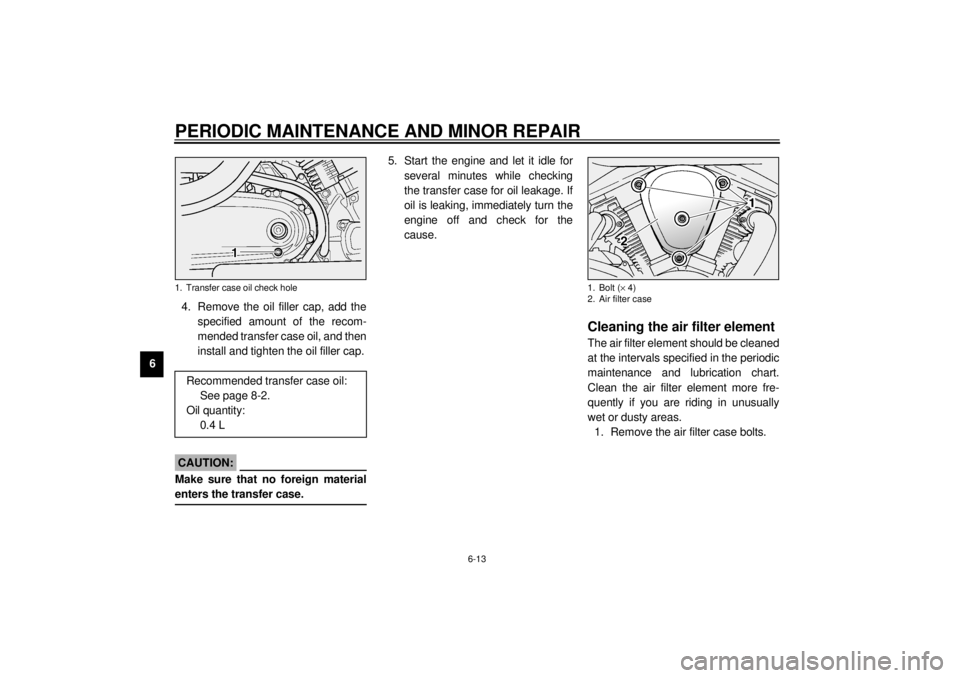
PERIODIC MAINTENANCE AND MINOR REPAIR
6-13
64. Remove the oil filler cap, add the
specified amount of the recom-
mended transfer case oil, and then
install and tighten the oil filler cap.
ECA00024
CAUTION:@ Make sure that no foreign material
enters the transfer case. @
5. Start the engine and let it idle for
several minutes while checking
the transfer case for oil leakage. If
oil is leaking, immediately turn the
engine off and check for the
cause.
EAU03707
Cleaning the air filter element The air filter element should be cleaned
at the intervals specified in the periodic
maintenance and lubrication chart.
Clean the air filter element more fre-
quently if you are riding in unusually
wet or dusty areas.
1. Remove the air filter case bolts.
1. Transfer case oil check holeRecommended transfer case oil:
See page 8-2.
Oil quantity:
0.4 L
1. Bolt (´ 4)
2. Air filter case
E_5JA.book Page 13 Wednesday, September 13, 2000 6:06 PM
Page 70 of 104
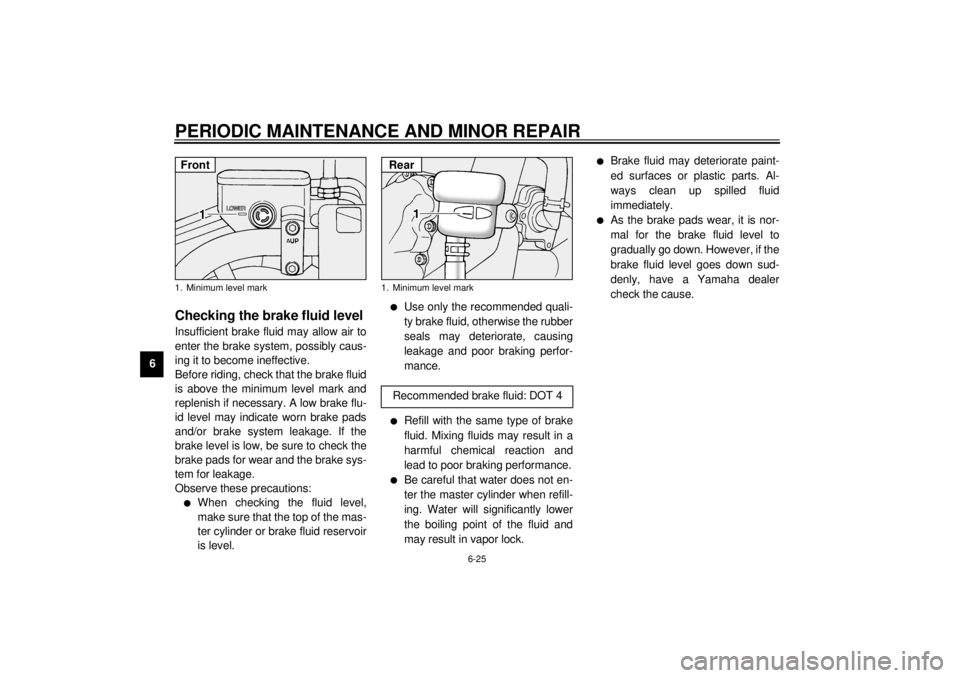
PERIODIC MAINTENANCE AND MINOR REPAIR
6-25
6
EAU03196
Checking the brake fluid level Insufficient brake fluid may allow air to
enter the brake system, possibly caus-
ing it to become ineffective.
Before riding, check that the brake fluid
is above the minimum level mark and
replenish if necessary. A low brake flu-
id level may indicate worn brake pads
and/or brake system leakage. If the
brake level is low, be sure to check the
brake pads for wear and the brake sys-
tem for leakage.
Observe these precautions:l
When checking the fluid level,
make sure that the top of the mas-
ter cylinder or brake fluid reservoir
is level.
l
Use only the recommended quali-
ty brake fluid, otherwise the rubber
seals may deteriorate, causing
leakage and poor braking perfor-
mance.
l
Refill with the same type of brake
fluid. Mixing fluids may result in a
harmful chemical reaction and
lead to poor braking performance.
l
Be careful that water does not en-
ter the master cylinder when refill-
ing. Water will significantly lower
the boiling point of the fluid and
may result in vapor lock.
l
Brake fluid may deteriorate paint-
ed surfaces or plastic parts. Al-
ways clean up spilled fluid
immediately.
l
As the brake pads wear, it is nor-
mal for the brake fluid level to
gradually go down. However, if the
brake fluid level goes down sud-
denly, have a Yamaha dealer
check the cause.
1. Minimum level markFront
1. Minimum level mark
Recommended brake fluid: DOT 4Rear
E_5JA.book Page 25 Wednesday, September 13, 2000 6:06 PM
Page 71 of 104
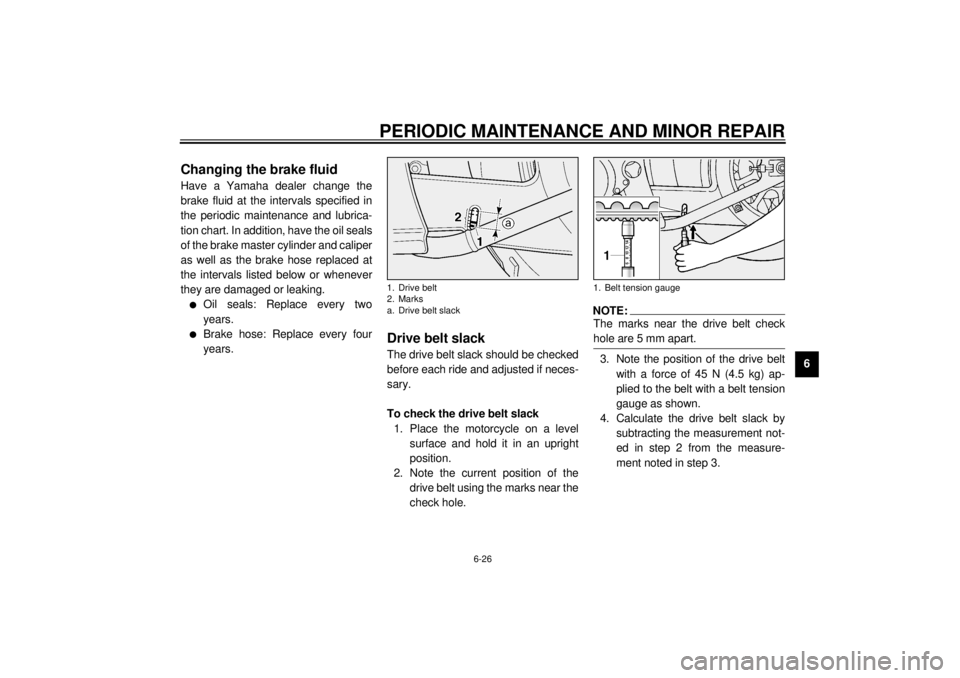
PERIODIC MAINTENANCE AND MINOR REPAIR
6-26
6
EAU03238
Changing the brake fluid Have a Yamaha dealer change the
brake fluid at the intervals specified in
the periodic maintenance and lubrica-
tion chart. In addition, have the oil seals
of the brake master cylinder and caliper
as well as the brake hose replaced at
the intervals listed below or whenever
they are damaged or leaking.l
Oil seals: Replace every two
years.
l
Brake hose: Replace every four
years.
EAU01830
Drive belt slack The drive belt slack should be checked
before each ride and adjusted if neces-
sary.
To check the drive belt slack
1. Place the motorcycle on a level
surface and hold it in an upright
position.
2. Note the current position of the
drive belt using the marks near the
check hole.
NOTE:@ The marks near the drive belt check
hole are 5 mm apart. @3. Note the position of the drive belt
with a force of 45 N (4.5 kg) ap-
plied to the belt with a belt tension
gauge as shown.
4. Calculate the drive belt slack by
subtracting the measurement not-
ed in step 2 from the measure-
ment noted in step 3.
1. Drive belt
2. Marks
a. Drive belt slack
1. Belt tension gauge
E_5JA.book Page 26 Wednesday, September 13, 2000 6:06 PM
Page 75 of 104
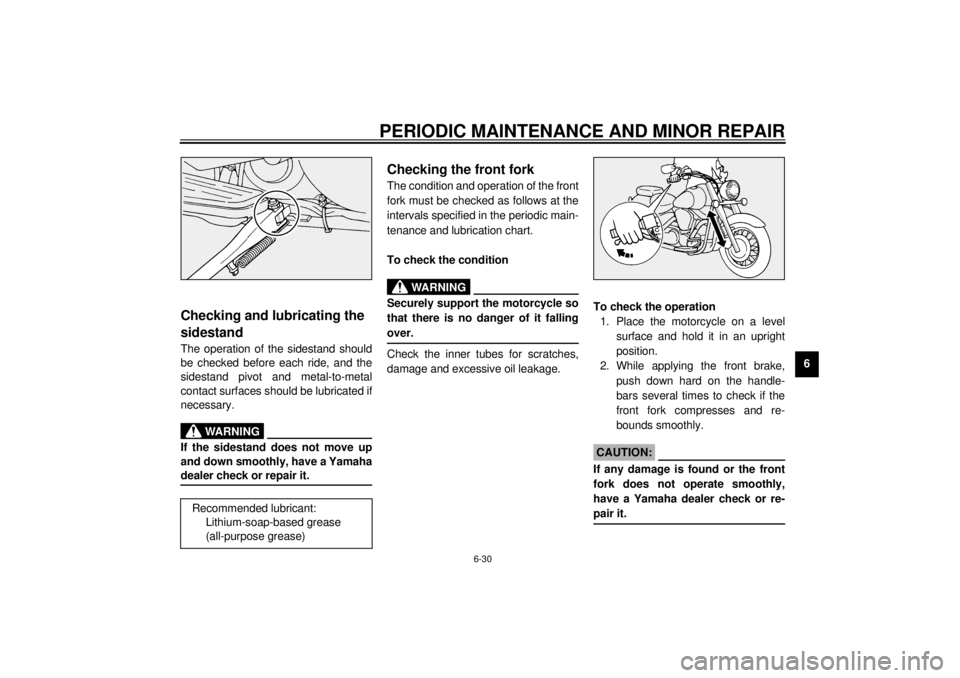
PERIODIC MAINTENANCE AND MINOR REPAIR
6-30
6
EAU03165
Checking and lubricating the
sidestand The operation of the sidestand should
be checked before each ride, and the
sidestand pivot and metal-to-metal
contact surfaces should be lubricated if
necessary.
EW000113
WARNING
@ If the sidestand does not move up
and down smoothly, have a Yamaha
dealer check or repair it. @
EAU02939
Checking the front fork The condition and operation of the front
fork must be checked as follows at the
intervals specified in the periodic main-
tenance and lubrication chart.
To check the condition
EW000115
WARNING
@ Securely support the motorcycle so
that there is no danger of it falling
over. @Check the inner tubes for scratches,
damage and excessive oil leakage.To check the operation
1. Place the motorcycle on a level
surface and hold it in an upright
position.
2. While applying the front brake,
push down hard on the handle-
bars several times to check if the
front fork compresses and re-
bounds smoothly.
EC000098
CAUTION:@ If any damage is found or the front
fork does not operate smoothly,
have a Yamaha dealer check or re-
pair it. @
Recommended lubricant:
Lithium-soap-based grease
(all-purpose grease)
E_5JA.book Page 30 Wednesday, September 13, 2000 6:06 PM
Page 81 of 104
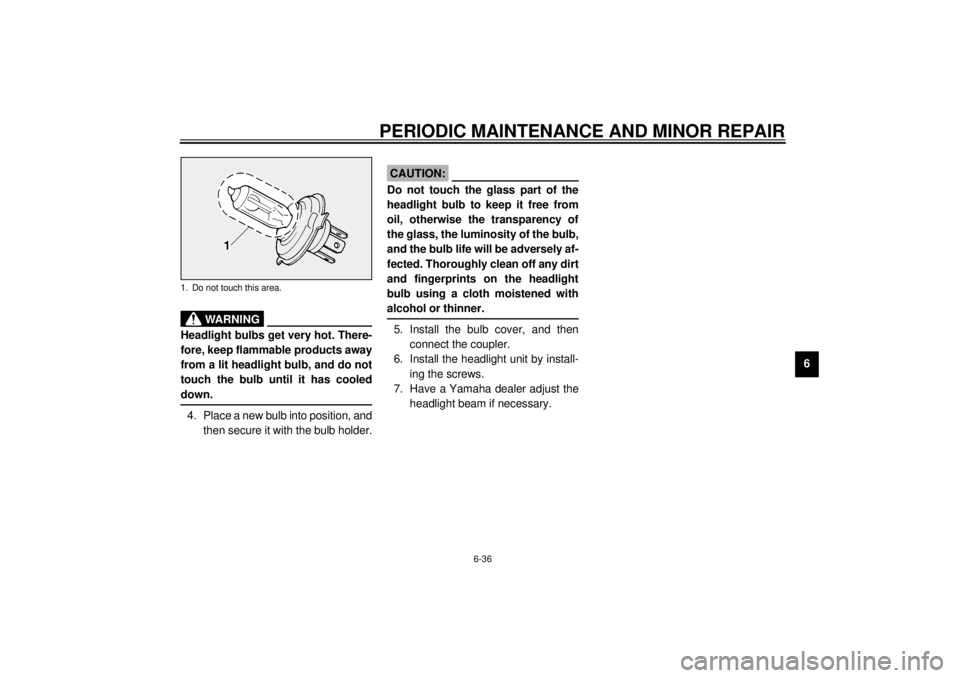
PERIODIC MAINTENANCE AND MINOR REPAIR
6-36
6
EW000119
WARNING
@ Headlight bulbs get very hot. There-
fore, keep flammable products away
from a lit headlight bulb, and do not
touch the bulb until it has cooled
down. @4. Place a new bulb into position, and
then secure it with the bulb holder.
EC000105
CAUTION:@ Do not touch the glass part of the
headlight bulb to keep it free from
oil, otherwise the transparency of
the glass, the luminosity of the bulb,
and the bulb life will be adversely af-
fected. Thoroughly clean off any dirt
and fingerprints on the headlight
bulb using a cloth moistened with
alcohol or thinner. @5. Install the bulb cover, and then
connect the coupler.
6. Install the headlight unit by install-
ing the screws.
7. Have a Yamaha dealer adjust the
headlight beam if necessary.
1. Do not touch this area.
E_5JA.book Page 36 Wednesday, September 13, 2000 6:06 PM
Page 86 of 104
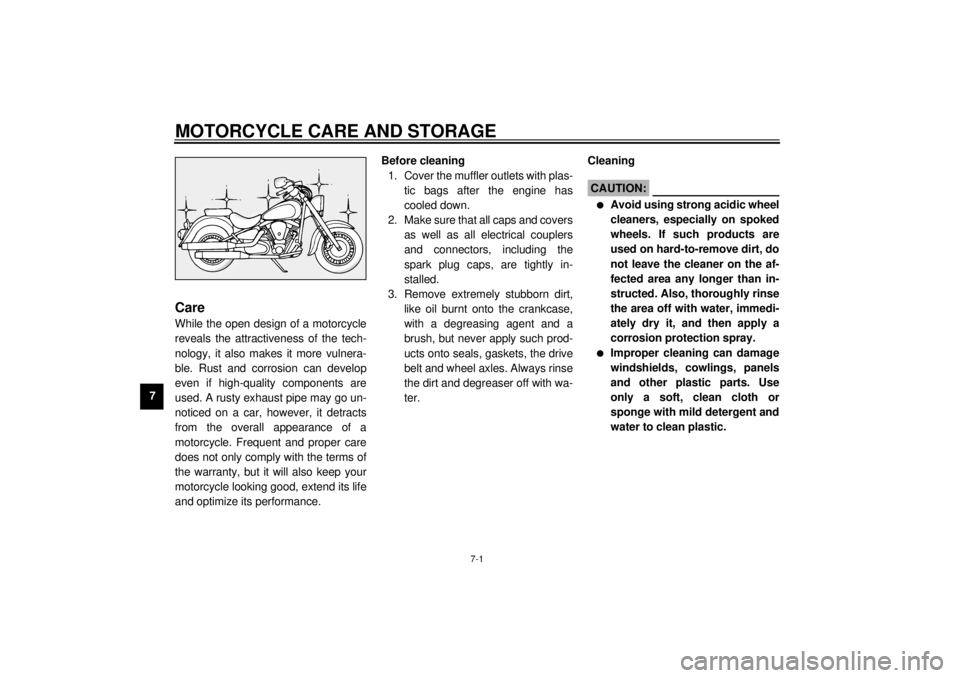
7-1
7
EAU03398
7-MOTORCYCLE CARE AND STORAGECare While the open design of a motorcycle
reveals the attractiveness of the tech-
nology, it also makes it more vulnera-
ble. Rust and corrosion can develop
even if high-quality components are
used. A rusty exhaust pipe may go un-
noticed on a car, however, it detracts
from the overall appearance of a
motorcycle. Frequent and proper care
does not only comply with the terms of
the warranty, but it will also keep your
motorcycle looking good, extend its life
and optimize its performance.Before cleaning
1. Cover the muffler outlets with plas-
tic bags after the engine has
cooled down.
2. Make sure that all caps and covers
as well as all electrical couplers
and connectors, including the
spark plug caps, are tightly in-
stalled.
3. Remove extremely stubborn dirt,
like oil burnt onto the crankcase,
with a degreasing agent and a
brush, but never apply such prod-
ucts onto seals, gaskets, the drive
belt and wheel axles. Always rinse
the dirt and degreaser off with wa-
ter.Cleaning
ECA00010
CAUTION:@ l
Avoid using strong acidic wheel
cleaners, especially on spoked
wheels. If such products are
used on hard-to-remove dirt, do
not leave the cleaner on the af-
fected area any longer than in-
structed. Also, thoroughly rinse
the area off with water, immedi-
ately dry it, and then apply a
corrosion protection spray.
l
Improper cleaning can damage
windshields, cowlings, panels
and other plastic parts. Use
only a soft, clean cloth or
sponge with mild detergent and
water to clean plastic.
E_5JA.book Page 1 Wednesday, September 13, 2000 6:06 PM
Page 88 of 104
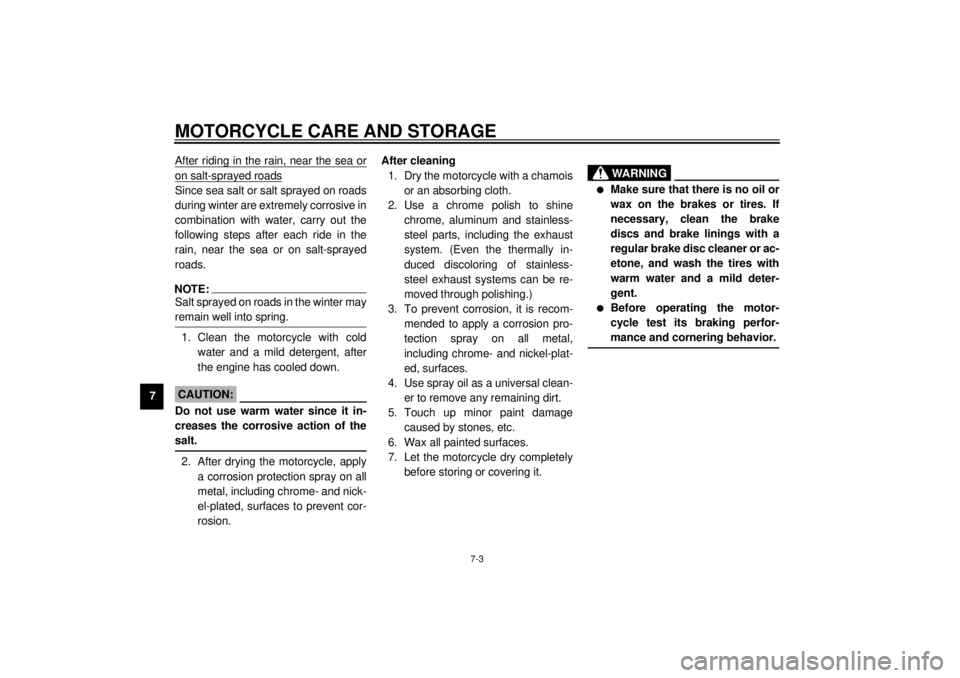
MOTORCYCLE CARE AND STORAGE
7-3
7After riding in the rain, near the sea or
on salt-sprayed roadsSince sea salt or salt sprayed on roads
during winter are extremely corrosive in
combination with water, carry out the
following steps after each ride in the
rain, near the sea or on salt-sprayed
roads.NOTE:@ Salt sprayed on roads in the winter may
remain well into spring. @1. Clean the motorcycle with cold
water and a mild detergent, after
the engine has cooled down.
ECA00012
CAUTION:@ Do not use warm water since it in-
creases the corrosive action of the
salt. @2. After drying the motorcycle, apply
a corrosion protection spray on all
metal, including chrome- and nick-
el-plated, surfaces to prevent cor-
rosion.After cleaning
1. Dry the motorcycle with a chamois
or an absorbing cloth.
2. Use a chrome polish to shine
chrome, aluminum and stainless-
steel parts, including the exhaust
system. (Even the thermally in-
duced discoloring of stainless-
steel exhaust systems can be re-
moved through polishing.)
3. To prevent corrosion, it is recom-
mended to apply a corrosion pro-
tection spray on all metal,
including chrome- and nickel-plat-
ed, surfaces.
4. Use spray oil as a universal clean-
er to remove any remaining dirt.
5. Touch up minor paint damage
caused by stones, etc.
6. Wax all painted surfaces.
7. Let the motorcycle dry completely
before storing or covering it.
EWA00001
WARNING
@ l
Make sure that there is no oil or
wax on the brakes or tires. If
necessary, clean the brake
discs and brake linings with a
regular brake disc cleaner or ac-
etone, and wash the tires with
warm water and a mild deter-
gent.
l
Before operating the motor-
cycle test its braking perfor-
mance and cornering behavior.
@
E_5JA.book Page 3 Wednesday, September 13, 2000 6:06 PM
Page 89 of 104
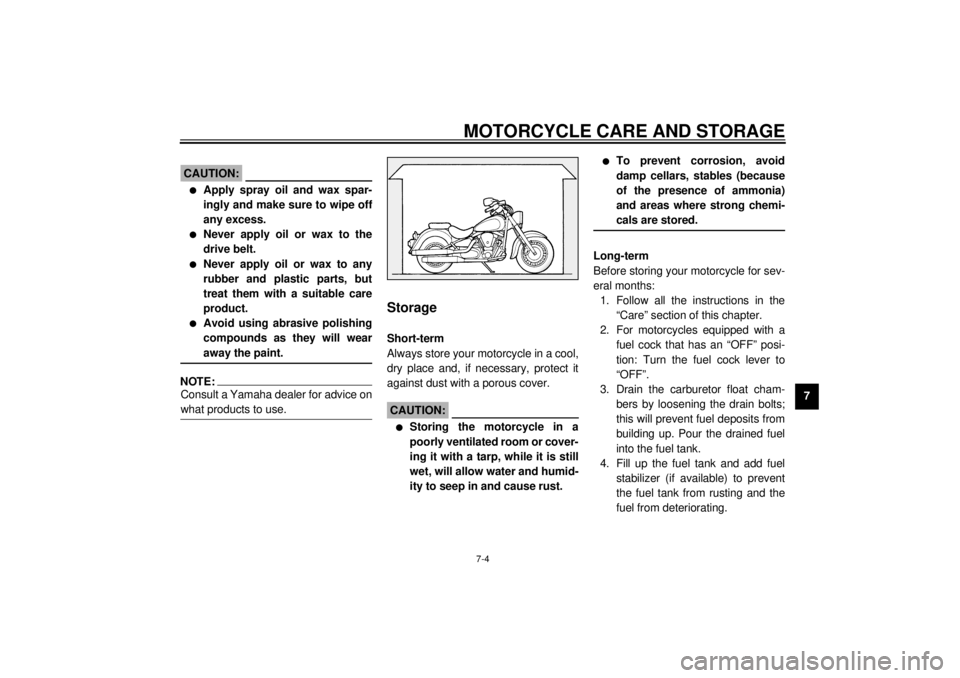
MOTORCYCLE CARE AND STORAGE
7-4
7
ECA00033
CAUTION:@ l
Apply spray oil and wax spar-
ingly and make sure to wipe off
any excess.
l
Never apply oil or wax to the
drive belt.
l
Never apply oil or wax to any
rubber and plastic parts, but
treat them with a suitable care
product.
l
Avoid using abrasive polishing
compounds as they will wear
away the paint.
@NOTE:@ Consult a Yamaha dealer for advice on
what products to use. @
Storage Short-term
Always store your motorcycle in a cool,
dry place and, if necessary, protect it
against dust with a porous cover.
ECA00014
CAUTION:@ l
Storing the motorcycle in a
poorly ventilated room or cover-
ing it with a tarp, while it is still
wet, will allow water and humid-
ity to seep in and cause rust.
l
To prevent corrosion, avoid
damp cellars, stables (because
of the presence of ammonia)
and areas where strong chemi-
cals are stored.
@Long-term
Before storing your motorcycle for sev-
eral months:
1. Follow all the instructions in the
“Care” section of this chapter.
2. For motorcycles equipped with a
fuel cock that has an “OFF” posi-
tion: Turn the fuel cock lever to
“OFF”.
3. Drain the carburetor float cham-
bers by loosening the drain bolts;
this will prevent fuel deposits from
building up. Pour the drained fuel
into the fuel tank.
4. Fill up the fuel tank and add fuel
stabilizer (if available) to prevent
the fuel tank from rusting and the
fuel from deteriorating.
E_5JA.book Page 4 Wednesday, September 13, 2000 6:06 PM
Page 90 of 104
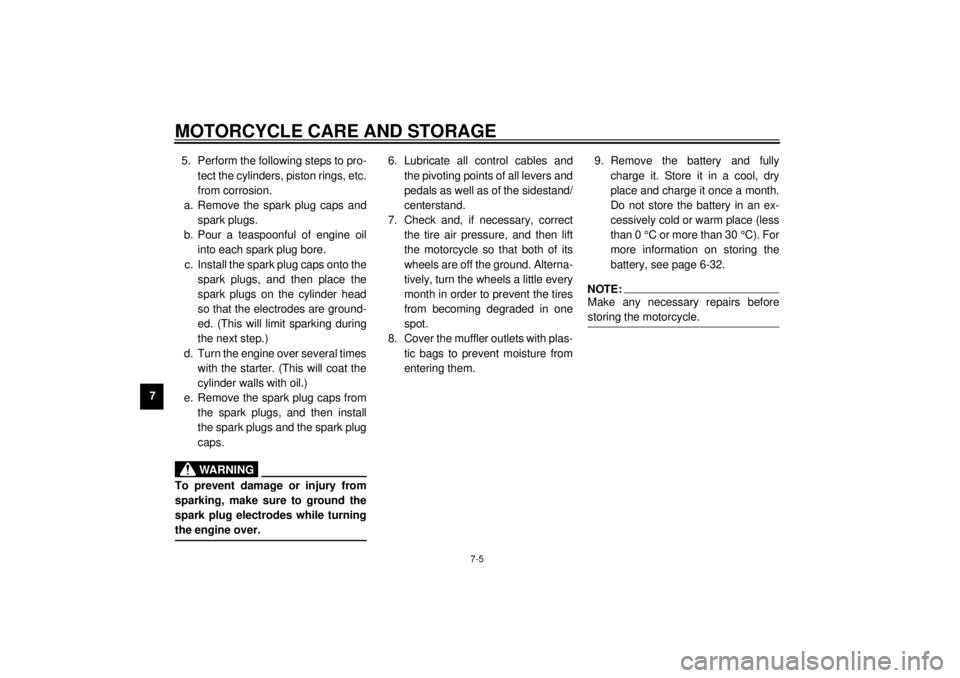
MOTORCYCLE CARE AND STORAGE
7-5
75. Perform the following steps to pro-
tect the cylinders, piston rings, etc.
from corrosion.
a. Remove the spark plug caps and
spark plugs.
b. Pour a teaspoonful of engine oil
into each spark plug bore.
c. Install the spark plug caps onto the
spark plugs, and then place the
spark plugs on the cylinder head
so that the electrodes are ground-
ed. (This will limit sparking during
the next step.)
d. Turn the engine over several times
with the starter. (This will coat the
cylinder walls with oil.)
e. Remove the spark plug caps from
the spark plugs, and then install
the spark plugs and the spark plug
caps.
EWA00003
WARNING
@ To prevent damage or injury from
sparking, make sure to ground the
spark plug electrodes while turning
the engine over. @
6. Lubricate all control cables and
the pivoting points of all levers and
pedals as well as of the sidestand/
centerstand.
7. Check and, if necessary, correct
the tire air pressure, and then lift
the motorcycle so that both of its
wheels are off the ground. Alterna-
tively, turn the wheels a little every
month in order to prevent the tires
from becoming degraded in one
spot.
8. Cover the muffler outlets with plas-
tic bags to prevent moisture from
entering them.9. Remove the battery and fully
charge it. Store it in a cool, dry
place and charge it once a month.
Do not store the battery in an ex-
cessively cold or warm place (less
than 0 °C or more than 30 °C). For
more information on storing the
battery, see page 6-32.
NOTE:@ Make any necessary repairs before
storing the motorcycle. @
E_5JA.book Page 5 Wednesday, September 13, 2000 6:06 PM
Page 92 of 104
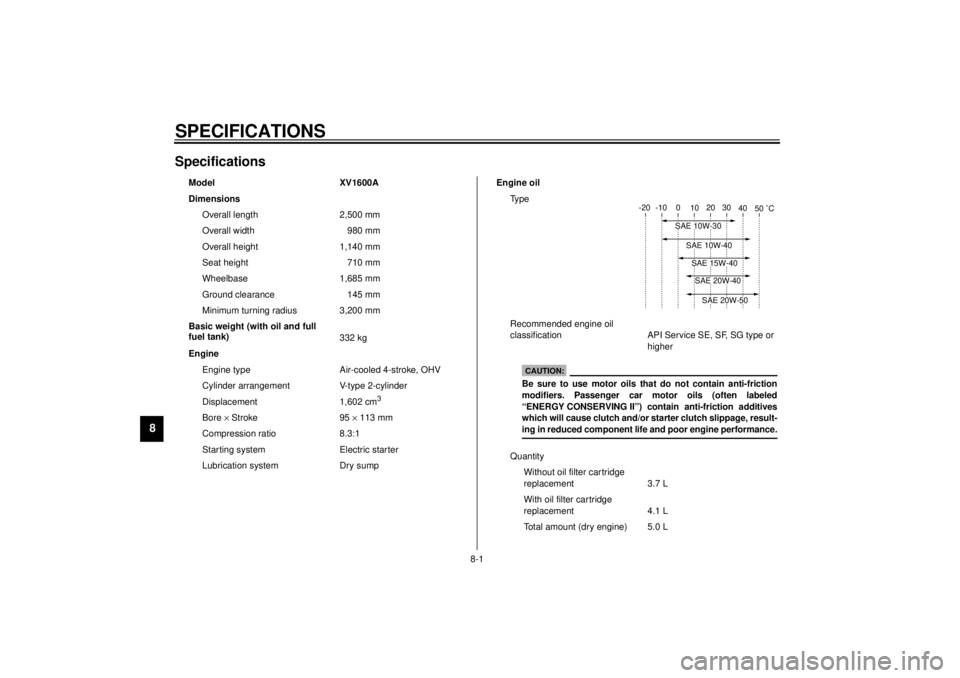
8-1
8
EAU01038
8-SPECIFICATIONSSpecifications CS-01E
Model XV1600A
Dimensions
Overall length 2,500 mm
Overall width 980 mm
Overall height 1,140 mm
Seat height 710 mm
Wheelbase 1,685 mm
Ground clearance 145 mm
Minimum turning radius 3,200 mm
Basic weight (with oil and full
fuel tank)
332 kg
Engine
Engine type Air-cooled 4-stroke, OHV
Cylinder arrangement V-type 2-cylinder
Displacement 1,602 cm
3
Bore ´ Stroke 95 ´ 113 mm
Compression ratio 8.3:1
Starting system Electric starter
Lubrication system Dry sumpEngine oil
Ty p e
Recommended engine oil
classification API Service SE, SF, SG type or
higher
Quantity
Without oil filter cartridge
replacement 3.7 L
With oil filter car tridge
replacement 4.1 L
Total amount (dry engine) 5.0 L
-20 -10 0
10 20 30
40
50 ˚C
SAE 10W-30
SAE 15W-40SAE 20W-40SAE 20W-50
SAE 10W-40
CAUTION:Be sure to use motor oils that do not contain anti-friction
modifiers. Passenger car motor oils (often labeled
“ENERGY CONSERVING II”) contain anti-friction additives
which will cause clutch and/or starter clutch slippage, result-
ing in reduced component life and poor engine performance.
E_5JA.book Page 1 Wednesday, September 13, 2000 6:06 PM